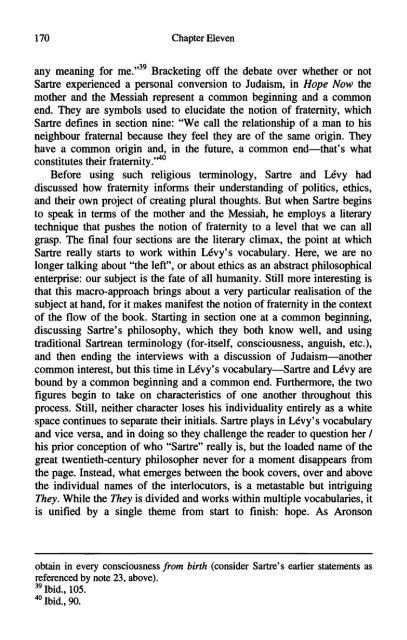Sartre's second century
Sartre's second century
Sartre's second century
You also want an ePaper? Increase the reach of your titles
YUMPU automatically turns print PDFs into web optimized ePapers that Google loves.
170 Chapter Eleven<br />
any meaning for me. Bracketing off the debate over whether or not<br />
Sartre experienced a personal conversion to Judaism, in Hope Now the<br />
mother and the Messiah represent a common beginning and a common<br />
end. They are symbols used to elucidate the notion of fraternity, which<br />
Sartre defines in section nine: "We call the relationship of a man to his<br />
neighbour fraternal because they feel they are of the same origin. They<br />
have a common origin and, in the future, a common end—that's what<br />
constitutes their fraternity." 40<br />
Before using such religious terminology, Sartre and Levy had<br />
discussed how fraternity informs their understanding of politics, ethics,<br />
and their own project of creating plural thoughts. But when Sartre begins<br />
to speak in terms of the mother and the Messiah, he employs a literary<br />
technique that pushes the notion of fraternity to a level that we can all<br />
grasp. The final four sections are the literary climax, the point at which<br />
Sartre really starts to work within Levy's vocabulary. Here, we are no<br />
longer talking about "the left", or about ethics as an abstract philosophical<br />
enterprise: our subject is the fate of all humanity. Still more interesting is<br />
that this macro-approach brings about a very particular realisation of the<br />
subject at hand, for it makes manifest the notion of fraternity in the context<br />
of the flow of the book. Starting in section one at a common beginning,<br />
discussing <strong>Sartre's</strong> philosophy, which they both know well, and using<br />
traditional Sartrean terminology (for-itself, consciousness, anguish, etc.),<br />
and then ending the interviews with a discussion of Judaism—another<br />
common interest, but this time in Levy's vocabulary—Sartre and Levy are<br />
bound by a common beginning and a common end. Furthermore, the two<br />
figures begin to take on characteristics of one another throughout this<br />
process. Still, neither character loses his individuality entirely as a white<br />
space continues to separate their initials. Sartre plays in Levy's vocabulary<br />
and vice versa, and in doing so they challenge the reader to question her /<br />
his prior conception of who "Sartre" really is, but the loaded name of the<br />
great twentieth-<strong>century</strong> philosopher never for a moment disappears from<br />
the page. Instead, what emerges between the book covers, over and above<br />
the individual names of the interlocutors, is a metastable but intriguing<br />
They. While the They is divided and works within multiple vocabularies, it<br />
is unified by a single theme from start to finish: hope. As Aronson<br />
obtain in every consciousness from birth (consider <strong>Sartre's</strong> earlier statements as<br />
referenced by note 23, above).<br />
39 Ibid., 105.<br />
40 Ibid., 90.
















